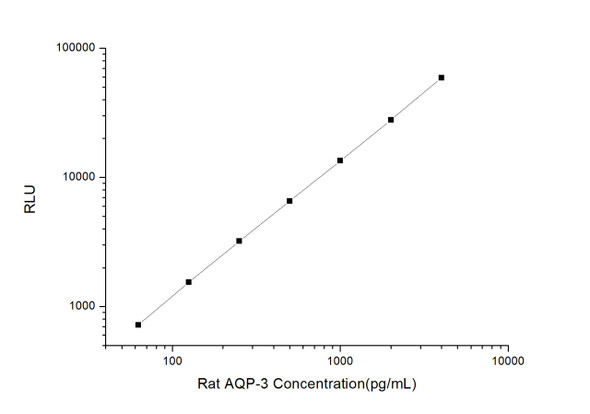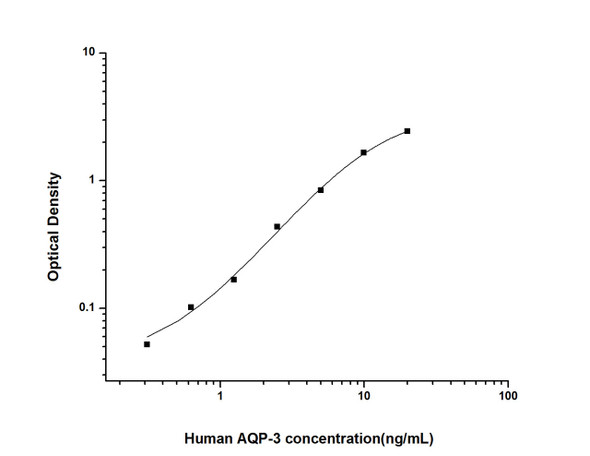Human Signal Transduction ELISA Kits
Human AQP-3 (Aquaporin 3) CLIA Kit (HUES00351)
- SKU:
- HUES00351
- Product Type:
- ELISA Kit
- ELISA Type:
- CLIA Kit
- Size:
- 96 Assays
- Sensitivity:
- 46.88pg/mL
- Range:
- 78.13-5000pg/mL
- ELISA Type:
- Sandwich
- Synonyms:
- AQP3, GIL
- Reactivity:
- Human
- Sample Type:
- Serum, plasma and other biological fluids
- Research Area:
- Signal Transduction
Description
| Assay type: | Sandwich |
| Format: | 96T |
| Assay time: | 4.5h |
| Reactivity: | Human |
| Detection method: | Chemiluminescence |
| Detection range: | 78.13-5000 pg/mL |
| Sensitivity: | 46.88 pg/mL |
| Sample volume: | 100µL |
| Sample type: | Serum, plasma and other biological fluids |
| Repeatability: | CV < 15% |
| Specificity: | This kit recognizes Human AQP-3 in samples. No significant cross-reactivity or interference between Human AQP-3 and analogues was observed. |
This kit uses Sandwich-CLIA as the method. The micro CLIA plate provided in this kit has been pre-coated with an antibody specific to Human AQP-3. Standards or samples are added to the appropriate micro CLIA plate wells and combined with the specific antibody. Then a biotinylated detection antibody specific for Human AQP-3 and Avidin-Horseradish Peroxidase (HRP) conjugate are added to each micro plate well successively and incubated. Free components are washed away. The substrate solution is added to each well. Only those wells that contain Human AQP-3, biotinylated detection antibody and Avidin-HRP conjugate will appear fluorescence. The Relative light unit (RLU) value is measured spectrophotometrically by the Chemiluminescence immunoassay analyzer. The RLU value is positively associated with the concentration of Human AQP-3. The concentration of Human AQP-3 in the samples can be calculated by comparing the RLU of the samples to the standard curve.
| UniProt Protein Function: | AQP3: Water channel required to promote glycerol permeability and water transport across cell membranes. Acts as a glycerol transporter in skin and plays an important role in regulating SC (stratum corneum) and epidermal glycerol content. Involved in skin hydration, wound healing, and tumorigenesis. Provides kidney medullary collecting duct with high permeability to water, thereby permitting water to move in the direction of an osmotic gradient. Slightly permeable to urea and may function as a water and urea exit mechanism in antidiuresis in collecting duct cells. It may play an important role in gastrointestinal tract water transport and in glycerol metabolism. Belongs to the MIP/aquaporin (TC 1. A. 8) family. 2 isoforms of the human protein are produced by alternative splicing. |
| UniProt Protein Details: | Protein type:Transporter; Channel, misc. ; Membrane protein, integral; Membrane protein, multi-pass; Transporter, aquaporin family Chromosomal Location of Human Ortholog: 9p13 Cellular Component: integral to plasma membrane; basolateral plasma membrane; cytoplasm; integral to membrane; plasma membrane; intercellular junction Molecular Function:transporter activity; urea transmembrane transporter activity; water channel activity; glycerol channel activity Biological Process: glycerol transport; positive regulation of immune system process; cellular water homeostasis; response to retinoic acid; water transport; excretion; odontogenesis; response to vitamin D; transport; renal water homeostasis; response to calcium ion; regulation of keratinocyte differentiation; transmembrane transport Disease: Gil Blood Group |
| NCBI Summary: | This gene encodes the water channel protein aquaporin 3. Aquaporins are a family of small integral membrane proteins related to the major intrinsic protein, also known as aquaporin 0. Aquaporin 3 is localized at the basal lateral membranes of collecting duct cells in the kidney. In addition to its water channel function, aquaporin 3 has been found to facilitate the transport of nonionic small solutes such as urea and glycerol, but to a smaller degree. It has been suggested that water channels can be functionally heterogeneous and possess water and solute permeation mechanisms. [provided by RefSeq, Aug 2011] |
| UniProt Code: | Q92482 |
| NCBI GenInfo Identifier: | 2497938 |
| NCBI Gene ID: | 360 |
| NCBI Accession: | Q92482. 2 |
| UniProt Secondary Accession: | Q92482,O00108, Q6FGT2, Q6FGW6, A8K843, B2RE16, D3DRL3 |
| UniProt Related Accession: | Q92482 |
| Molecular Weight: | 29,987 Da |
| NCBI Full Name: | Aquaporin-3 |
| NCBI Synonym Full Names: | aquaporin 3 (Gill blood group) |
| NCBI Official Symbol: | AQP3 |
| NCBI Official Synonym Symbols: | GIL; AQP-3 |
| NCBI Protein Information: | aquaporin-3; aquaglyceroporin-3; aquaporin 3 (GIL blood group) |
| UniProt Protein Name: | Aquaporin-3 |
| UniProt Synonym Protein Names: | Aquaglyceroporin-3 |
| Protein Family: | Aquaporin |
| UniProt Gene Name: | AQP3 |
| UniProt Entry Name: | AQP3_HUMAN |
As the RLU values of the standard curve may vary according to the conditions of the actual assay performance (e. g. operator, pipetting technique, washing technique or temperature effects), the operator should establish a standard curve for each test. Typical standard curve and data is provided below for reference only.
| Concentration (pg/mL) | RLU | Average | Corrected |
| 5000 | 55555 66957 | 61256 | 61233 |
| 2500 | 33402 35306 | 34354 | 34331 |
| 1250 | 18696 17642 | 18169 | 18146 |
| 625 | 8879 9905 | 9392 | 9369 |
| 312.5 | 4907 4759 | 4833 | 4810 |
| 156.25 | 2601 2421 | 2511 | 2488 |
| 78.13 | 1298 1380 | 1339 | 1316 |
| 0 | 23 23 | 23 | -- |
Precision
Intra-assay Precision (Precision within an assay): 3 samples with low, mid range and high level Human AQP-3 were tested 20 times on one plate, respectively.
Inter-assay Precision (Precision between assays): 3 samples with low, mid range and high level Human AQP-3 were tested on 3 different plates, 20 replicates in each plate.
| Intra-assay Precision | Inter-assay Precision | |||||
| Sample | 1 | 2 | 3 | 1 | 2 | 3 |
| n | 20 | 20 | 20 | 20 | 20 | 20 |
| Mean (pg/mL) | 257.30 | 592.15 | 2128.75 | 259.71 | 623.53 | 1968.13 |
| Standard deviation | 26.27 | 47.19 | 132.41 | 27.48 | 73.45 | 190.91 |
| C V (%) | 10.21 | 7.97 | 6.22 | 10.58 | 11.78 | 9.70 |
Recovery
The recovery of Human AQP-3 spiked at three different levels in samples throughout the range of the assay was evaluated in various matrices.
| Sample Type | Range (%) | Average Recovery (%) |
| Serum (n=5) | 97-113 | 104 |
| EDTA plasma (n=5) | 94-107 | 101 |
| Cell culture media (n=5) | 87-99 | 93 |
Linearity
Samples were spiked with high concentrations of Human AQP-3 and diluted with Reference Standard & Sample Diluent to produce samples with values within the range of the assay.
| Serum (n=5) | EDTA plasma (n=5) | Cell culture media (n=5) | ||
| 1:2 | Range (%) | 84-98 | 96-108 | 94-109 |
| Average (%) | 91 | 102 | 100 | |
| 1:4 | Range (%) | 101-113 | 88-100 | 87-104 |
| Average (%) | 106 | 93 | 95 | |
| 1:8 | Range (%) | 86-99 | 86-99 | 87-99 |
| Average (%) | 93 | 91 | 93 | |
| 1:16 | Range (%) | 100-115 | 95-109 | 92-106 |
| Average (%) | 106 | 101 | 100 |
An unopened kit can be stored at 4°C for 1 month. If the kit is not used within 1 month, store the items separately according to the following conditions once the kit is received.
| Item | Specifications | Storage |
| Micro CLIA Plate(Dismountable) | 8 wells ×12 strips | -20°C, 6 months |
| Reference Standard | 2 vials | |
| Concentrated Biotinylated Detection Ab (100×) | 1 vial, 120 µL | |
| Concentrated HRP Conjugate (100×) | 1 vial, 120 µL | -20°C(shading light), 6 months |
| Reference Standard & Sample Diluent | 1 vial, 20 mL | 4°C, 6 months |
| Biotinylated Detection Ab Diluent | 1 vial, 14 mL | |
| HRP Conjugate Diluent | 1 vial, 14 mL | |
| Concentrated Wash Buffer (25×) | 1 vial, 30 mL | |
| Substrate Reagent A | 1 vial, 5 mL | 4°C (shading light) |
| Substrate Reagent B | 1 vial, 5 mL | 4°C (shading light) |
| Plate Sealer | 5 pieces | |
| Product Description | 1 copy | |
| Certificate of Analysis | 1 copy |
- Set standard, test sample and control (zero) wells on the pre-coated plate and record theirpositions. It is recommended to measure each standard and sample in duplicate. Note: addall solutions to the bottom of the plate wells while avoiding contact with the well walls. Ensuresolutions do not foam when adding to the wells.
- Aliquot 100µl of standard solutions into the standard wells.
- Add 100µl of Sample / Standard dilution buffer into the control (zero) well.
- Add 100µl of properly diluted sample (serum, plasma, tissue homogenates and otherbiological fluids. ) into test sample wells.
- Cover the plate with the sealer provided in the kit and incubate for 90 min at 37°C.
- Aspirate the liquid from each well, do not wash. Immediately add 100µL of BiotinylatedDetection Ab working solution to each well. Cover the plate with a plate seal and gently mix. Incubate for 1 hour at 37°C.
- Aspirate or decant the solution from the plate and add 350µL of wash buffer to each welland incubate for 1-2 minutes at room temperature. Aspirate the solution from each well andclap the plate on absorbent filter paper to dry. Repeat this process 3 times. Note: a microplatewasher can be used in this step and other wash steps.
- Add 100µL of HRP Conjugate working solution to each well. Cover with a plate seal andincubate for 30 min at 37°C.
- Aspirate or decant the solution from each well. Repeat the wash process for five times asconducted in step 7.
- Add 100µL of Substrate mixture solution to each well. Cover with a new plate seal andincubate for no more than 5 min at 37°C. Protect the plate from light.
- Determine the RLU value of each well immediately.






